Tom's Guide Verdict
The MSI Trident offers VR-ready gaming performance within a stunningly compact and quiet design.
Pros
- +
Incredibly small and attractive
- +
Runs quiet
- +
Solid gaming and VR performance
- +
Fairly affordable
Cons
- -
Limited to GTX 1060
- -
Not very future-proof
Why you can trust Tom's Guide
Editor's Note: MSI currently offers a newer version of the Trident called the Trident 3, which features the latest 7th-generation Intel processors while retaining the same design and components.
Most modern gaming PCs are either built to immerse you in virtual reality or are fighting for a spot in your entertainment center. The MSI Trident is a wonderful marriage of both. This desktop's exceptionally compact design gives the PS4 and Xbox One a genuine run for their money, while the Trident's custom Nvidia GTX 1060 graphics card and convenient port layout make enjoying virtual reality in your living room easy. Although limited configurations and a lack of easy upgradability hamper this machine, the MSI Trident is the best attempt I've seen yet at luring console fans into the world of PC gaming.
Design and Lighting
There are tons of compact gaming PCs out there, but few look as hand-built for the living room as the MSI Trident does. This striking desktop's sleek angles and mix of glossy and matte-black plastic take some cues from the PS4 and Xbox One, though its glowing LED lights and exposed GPU fan clearly identify this machine as a different kind of beast.
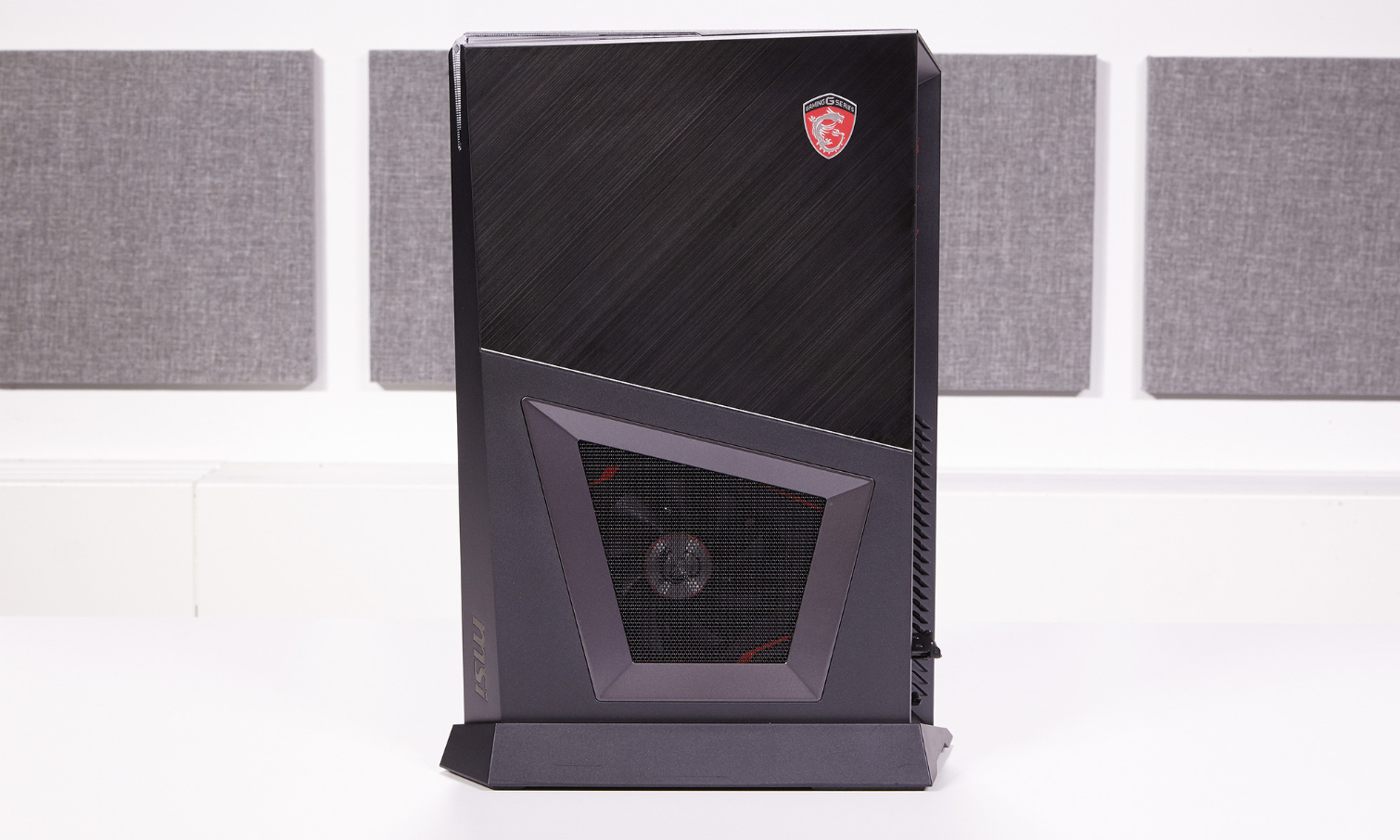
At just 13.6 x 3.8 x 2.8 inches and 7 pounds, the Trident should slide into your entertainment center just fine, and it's light enough to carry in a backpack. There's even an included stand for those who'd prefer to prop the PC up vertically. It's not quite as tiny as the square-shaped Alienware Alpha, but it won't take up more space than an Xbox One or PS4.
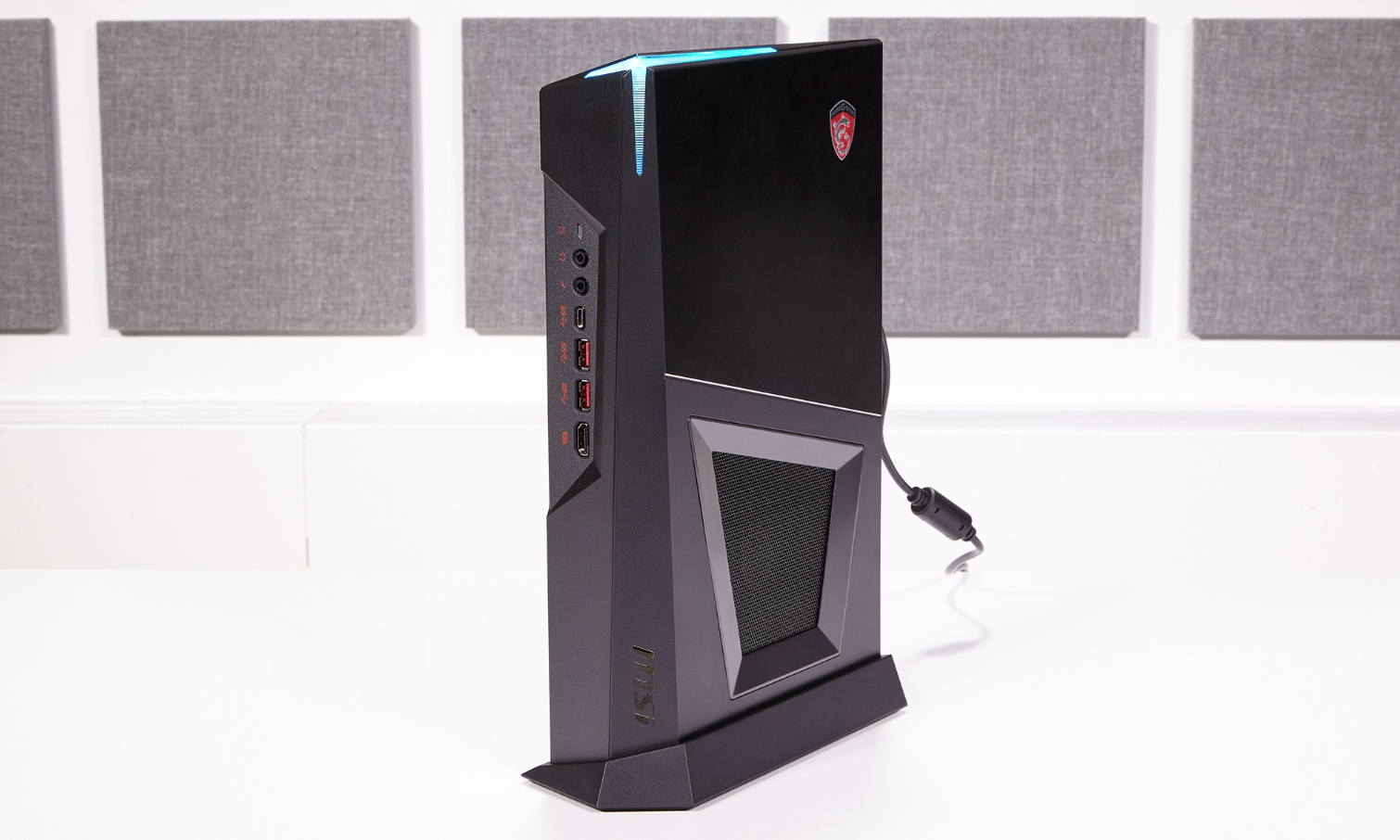
The Trident sports an eye-catching "Mystic Light" LED strip that spills over the desktop's left edge. This strip is highly customizable; you can have it glow a single color statically, run through all the colors of the rainbow, or pulsate in and out.
MORE: The Best Gaming Desktops Available Now
You can even have the strip glow dynamically based on the audio coming out of the PC, which was easily my favorite feature. When I fired up the Doom sound track, the Trident treated me to a hypnotizing light show that synced up perfectly with the music's unrelenting heavy-metal riffs. These lighting features aren't uncommon on gaming PCs, but I appreciated getting them on a system small enough to fit under my TV.
Specs
| MSI Trident | Starting Configuration | Our Configuration |
| Price | $899 | $1,099 |
| CPU | Intel Core i5-6400 | Intel Core i7-6700 |
| GPU | Nvidia GTX 1060 | Nvidia GTX 1060 |
| RAM | 8GB | 8GB |
| Storage | 1TB hard drive | 128GB SSD, 1TB hard drive |
| Size and Weight | 13.6 x 3.8 x 2.8 inches, 7 pounds | 13.6 x 3.8 x 2.8 inches, 7 pounds |
Ports and Upgradability
As a gaming PC made for living rooms, the Trident does an excellent job of placing its most essential ports front and center. You'll have easy plug-and-play access to two USB 3.0 ports, a USB Type-C port, headphone and mic jacks, and even a front-facing HDMI port made specifically for connecting a VR headset.
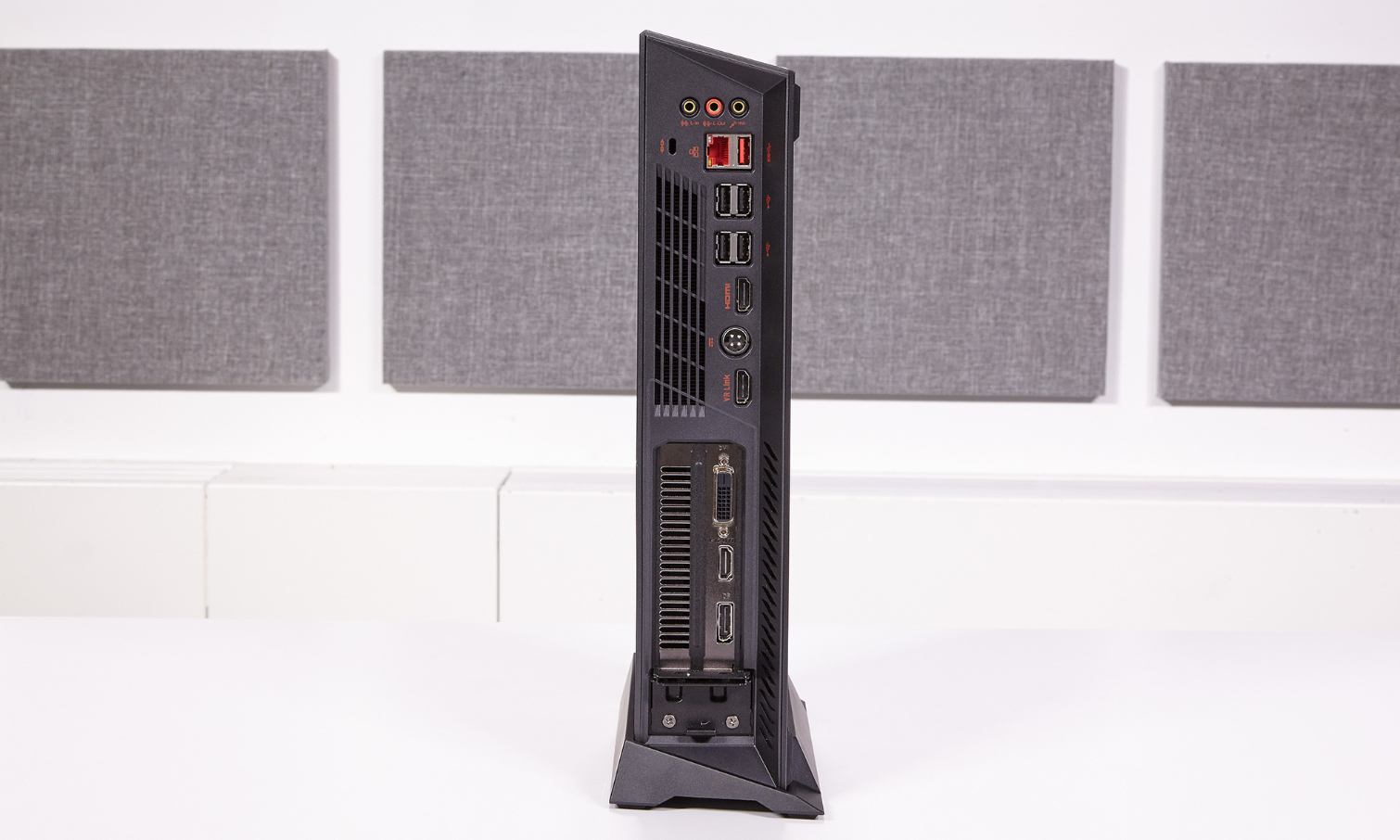
In the back, you'll find four USB 2.0 ports, a USB 3.0 port, an Ethernet jack, line in/out connections, a microphone jack and another VR-optimized HDMI port should you prefer to connect your headset to the rear of the PC. The Trident's Nvidia GTX 1060 GPU sports HDMI, DisplayPort and DVI ports, giving you a few options for connecting to your monitor.
The Trident's pleasantly small size and user-friendliness come with a cost: no easy upgradability. You can open the PC's case to replace components such as the RAM, storage and CPU, though this requires removing a few screws. This wouldn't be a major issue if the Trident could be configured with higher-end GPUs, but considering that you're stuck with a GTX 1060, the desktop might have trouble keeping up with the latest games in a few years.
Gaming and VR Performance
Despite its tiny size, the Trident can play most modern games at high settings, and it's one of the smallest VR-ready desktops out there thanks to its Nvidia GTX 1060 graphics card. The GPU has a custom design built specifically for the Trident's small frame, which stayed whisper quiet during the bulk of my gaming time with it.
On our Rise of the Tomb Raider benchmark (1080p with all settings maxed out), the Trident churned out a solid 31.5 frames per second. Anecdotally speaking, I played at a smooth 60 fps using the less-demanding High preset at 1080p, but the game sunk to a just less-than-playable 25 fps when I tried out 4K.
MSI's desktop made quick work of our Hitman benchmark (1080p, max settings), running the sleek assassination simulator at a breezy 78 fps. The Trident had a harder time with the crowded open-world action of Grand Theft Auto V, running our 1080p, max settings benchmark at a just-barely playable 29.6 fps.
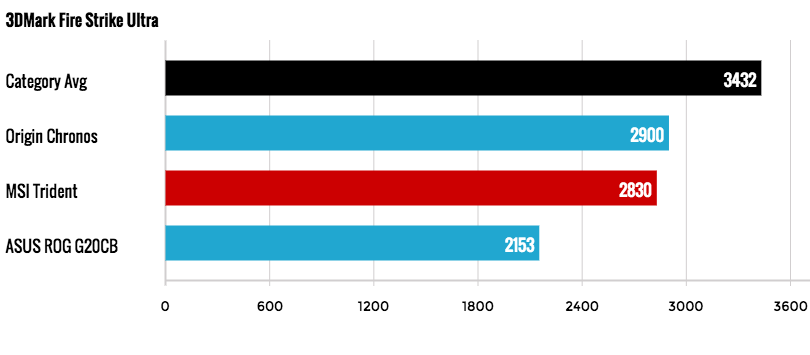
The Trident scored a 2,830 on the 3DMark Fire Strike Ultra benchmark, topping the Asus G20CB (GTX 970; 2,153 score) but trailing the Origin Chronos VR (GTX 970; 2,900 score) as well as our 3,432 gaming-desktop average.
The Trident lives up to its claim of being a miniature VR machine, scoring 7.3 on the SteamVR Performance Test and falling well into Valve's "VR-Ready" threshold. To put this score in perspective, machines running Nvidia's highest-end GTX 1080 cards typically score around 11, while older, GTX 970-powered desktops usually land closer to 6.
MORE: Why Does Virtual Reality Make Some People Sick?
Overall Performance
Packing an Intel Core i7-6700K with 8GB of RAM, the Trident proved to be just as valuable a productivity workhorse as it was a small gaming system. The PC never faltered while I was multitasking, even as I flipped through a dozen browser tabs, watched four Twitch streams, downloaded a game and ran a full system scan, all at once.
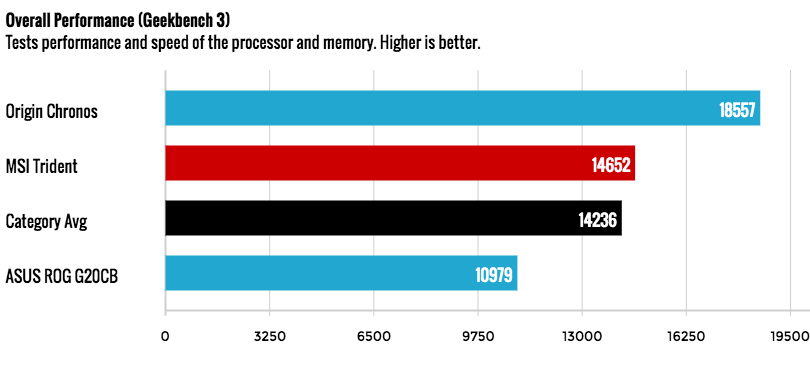
MSI's PC scored 14,652 on the Geekbench 3 general performance test, trailing the Origin Chronos (18,557, Core i7-6700K) but topping the Asus G20CB (10,979, Core i5-6400) as well as our 14,236 gaming-desktop average.
Our system's 128GB SSD copied about 5GB of files in 38 seconds, for a transfer rate of 133.92 MBps. That's a bit behind the G20CB and Chronos (both of which netted around 171 MBps with 512GB and 250GB SSDs, respectively) as well as our 198 MBps average for gaming PCs.
Software
As with most MSI PCs, the Trident comes loaded with a lean but useful selection of extra apps. The MSI Gaming Center is a central hub for monitoring system performance and customizing the LED lights, while the included Nahimic Audio Enhancer lets you tweak the PC's audio output and toggle features such as Bass Boost and Virtual Surround.
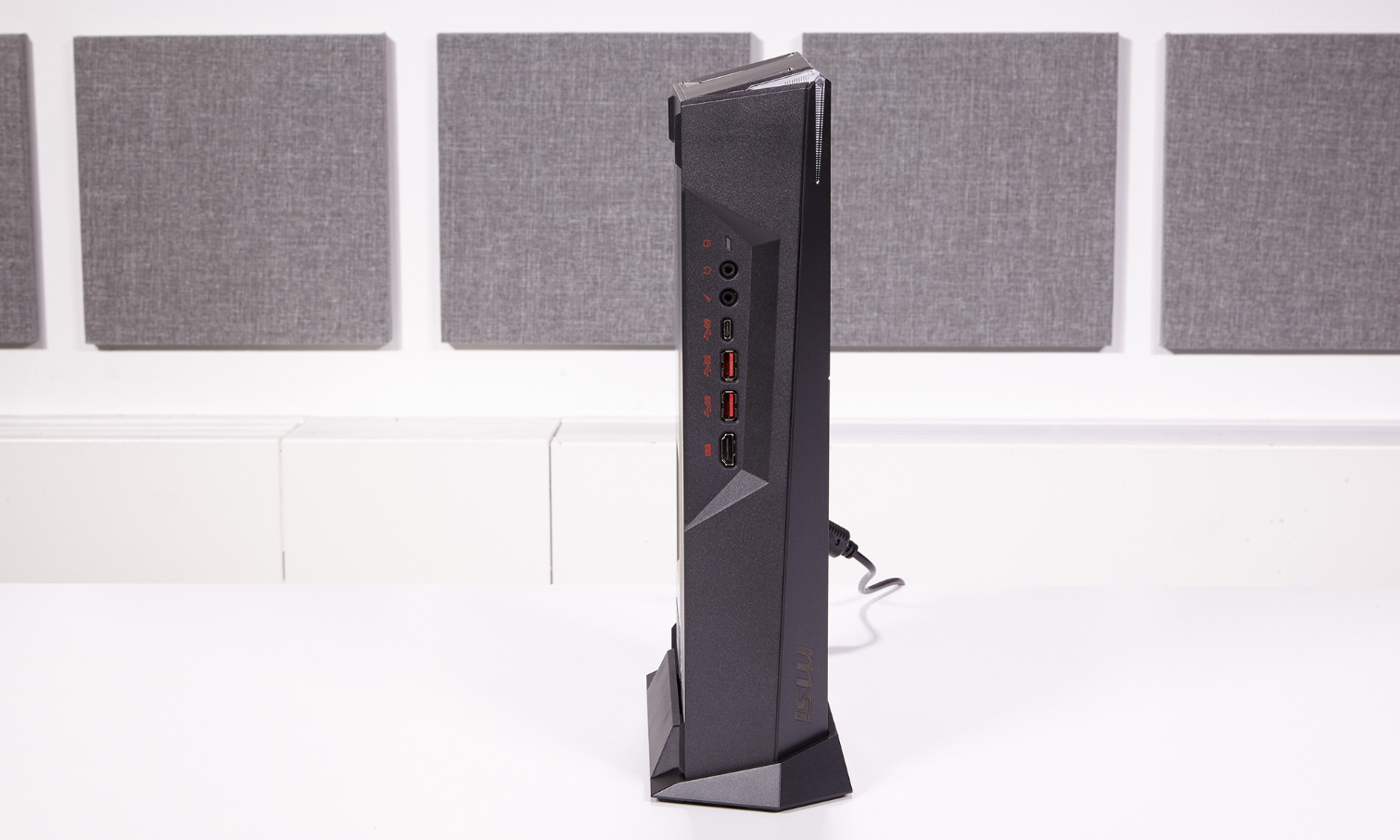
The best freebie here is the one-year license for XSplit Gamecaster, a popular live-streaming app that lets you easily broadcast to places like Twitch and YouTube.
Configurations and Value
The cheapest MSI Trident configuration is a $599 bare-bones unit, which includes an Nvidia GTX 1060 graphics card but requires you to supply your own processor, RAM, storage and operating system. Fully configured Trident models start at $899, which gets you an Intel Core i5-6400 processor, 8GB of RAM and a 1TB hard drive.
The Trident's pleasantly small size and user-friendliness come with the cost: no easy upgradability.
A $949 model adds a 128GB SSD, while the $1,099 unit we reviewed features a faster Intel Core i7-6700 processor. All versions of the Trident ship with a GTX 1060 graphics card, which is a double-edged sword: This GPU helps keep the Trident both fairly affordable and VR-ready, though I'd appreciate a GTX 1070 or 1080 option for 4K gaming and a more optimal VR experience.
The Trident's closest console-like competitor is the Alienware Alpha, which starts at a more affordable $499 but has a weaker Core i3 processor and an older Nvidia GTX 960 graphics card.
MORE: Most Anticipated Games
That technically meets the Oculus Rift's newly lowered requirements. However, the only way to have a dependable VR experience on the Alpha is to connect it to Alienware's $200 graphics amplifier and add a graphics card of your choosing.
The Alpha does have the benefit of its unique, controller-friendly HiveMind interface, though you'll have just as easy of a time browsing your game library on the Trident using tools like Steam's Big Picture mode.
Bottom Line
Based on design alone, I would happily replace my PS4 or Xbox One with an MSI Trident. Its slim profile, customizable lights and ultraquiet fans make it a perfect fit for the living room, while its Core i7 processor and GTX 1060 graphics allow you to enjoy high-quality VR or play graphically rich PC games from the couch.
However, while the Trident is brilliantly built, it's not exactly future-proof. You can't configure the PC with anything better than a 1060, and upgrading it will require you to get your hands dirty. The Trident is far more impressive than Alienware's Alpha out of the box, but the Alpha at least supports an external graphics dock. There's also the Acer Predator G1 ($2,299 as reviewed), which is much pricier but comes outfitted with a 4K-ready GTX 1080.
Still, while there are better options out there for folks who prioritize power, the MSI Trident is an excellent console replacement, and one of the most impressive plug-and-play gaming PCs I've used yet.
Mike Andronico is Senior Writer at CNNUnderscored. He was formerly Managing Editor at Tom's Guide, where he wrote extensively on gaming, as well as running the show on the news front. When not at work, you can usually catch him playing Street Fighter, devouring Twitch streams and trying to convince people that Hawkeye is the best Avenger.
-
JeffDaemon Console killer...wtf does that even mean now? Do we really need to compare the 2, ever again? PCs can easily outstrip consoles in graphics, it just doesn't get all the games. Want MMO and shooters? Get a PC. Want exclusive sports games, final fantasy 15, and last guardian? Console.Reply

